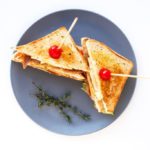While snacking is encouraged in young growing children, constant grazing and inappropriate snack choices can undo the benefit of regular meals. The need for regular meals is a simple one. Children have a small stomach capacity but a large nutrition requirement. This nutrient requirement encompasses both energy and nutrients and can only be met with the regular intake of nutrient dense meals.
All too often though, snacks in between meals are viewed as a time to ward off hunger or treat chidren rather than a time to nourish. Small meals eaten in between meals should assist in the meeting of a child’s nutrient requirements. Food choices for these small meals should not push the daily energy intake into excess, nor should they be void of nutrients such as fibre, protein, vitamins and minerals.
Snacks and treats are two very different things and unfortunately too many of the convenient ‘snack foods’ in the supermarkets are more treat than food. Some are especially deceptive, making label reading of great importance.
Choosing appropriate and satisfying snack foods can make all the difference in meeting a child’s nutrient needs. Substituting even just one snack time with a non-nutritious food on a daily basis could be sabotaging an otherwise healthy diet as a nutrient gap forms whenever this occurs. For example, if a piece of chocolate cake is eaten after school instead of a boiled egg and a fruit, not only has the energy consumption of that snack been too large but there is an absence of fibre, protein, vitamins, minerals and water. This absence could lead to a deficit in nutrients. Coupled with an excessive energy intake; the child’s blood sugar levels, appetite control, weight maintenance and overall health will be negatively impacted.
High energy convenient snack foods may not always satisfy, leaving children hungry within an hour. Grazing or overeating at the next meal is likely to occur. Mid-morning and mid-afternoon snacks should both nourish and satisfy until the next meal time. A minimum gap of 3 hours between meals helps the body to process a meal adequately before the next meal. This promotes stable blood glucose levels and in turn stable appetite, mood and concentration.
How to read labels
Checking the list of ingredients is a good place to start as the ingredients are listed in descending order of quantity. If sugar (glucose, syrup, honey, sucrose) is in the first three ingredients, it can be assumed that the product is high in sugar. Palm oil and high fructose corn syrup are commonly used in commercially made snack food products and should be limited in a healthy diet. Being aware of these three ingredients helps consumers to make better choices.
When it comes to fat, unsaturated fats are healthier than saturated fats and should therefore make up the bulk of a child’s daily fat intake. Fats are generally listed separately in the nutrient composition table and can therefore be easily compared. Transfats should be limited as far as possible.
Looking for nutrients is also important. Fibre is key nutrient to look for in the nutrient composition table. A product must have 6 grams or more fibre per 100 grams to be considered as high in fibre. A product that is high in fibre tends to be low in sugar and saturated fats. It is a good rule of thumb to use as a quick reference.
Label reading is an easy skill to develop and is likely to become a completely subconscious habit. The knowledge that this skill brings cannot be unlearned and acts as a powerful tool when making food decisions. Marketing, while very attractive and effective, can also be deceptive. The best way to counteract this is by checking the science which is provided by law right on the label for all to see.
Naturally nutritious snacks
- Fresh fruit
- Dried fruit (without sugar dusting)
- Raw nuts
- Popcorn (air popped and lightly salted)
- Trail mix (nuts, popcorn, seeds, raisins)
- Apple and peanut butter
- Dates and peanut butter
- Whole grain crackers with cottage cheese
- Plain yoghurt with fruit
- Smoothies
- Vegetables and hummus
- Meat balls and baby carrots
- Orange wedges and raw nuts
- Unsalted peanuts and raisins
- Boiled egg on whole wheat toast

